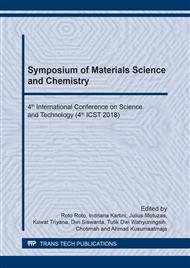[1]
Martawijaya, I. Kartasujana, K. Kadir, S.A. Prawira, Altas Kayu Indonesia-Jilid 1, (2005).
Google Scholar
[2]
D. Purwanto, Samet, Mahfuz, Sakiman, Pemanfaatan Limbah Industri Kayu Lapis untuk Papan Partikel Buatan secara Laminasi, DIP Proyek Penelitian dan Pengembangan Industri, (1994).
DOI: 10.20543/mkkp.v28i1.204
Google Scholar
[3]
D. Irawati, P.A. Mardika, Marsoem, S. Nugroh, Bio-ethanol production from meranti sawdust with pre-treatment using Ca(OH)2, in: Prosiding Seminar Nasional Mapeki XII, 2009, pp.658-666.
Google Scholar
[4]
S. Bahri, Pemanfaatan Limbah Industri Pengolahan Kayu untuk Pembuatan Briket Arang dalam Mengurangi Pencemaran Lingkungan di Nanggroe Aceh Darussalam, (2008).
Google Scholar
[5]
A.T. Yuliansyah, T. Hirajima, S. Kumagai, K. Sasaki, Production of solid biofuel from agricultural wastes of the palm oil industry by hydrothermal treatment, Waste Biomass Valor. 1 (2010) 395-405.
DOI: 10.1007/s12649-010-9045-3
Google Scholar
[6]
S. Karagӧz, T. Bhaskar, A. Muto, Y. Sakata, Comparative studies of oil compositions produced from sawdust, rice husk, lignin and cellulose by hydrothermal treatment, Fuel 84 (2005) 875-884.
DOI: 10.1016/j.fuel.2005.01.004
Google Scholar
[7]
Z. Wang, W. Lin, W. Song, Liquid product from hydrothermal treatment of cellulose by direct gc/ms analysis, Appl. Energy 97 (2012) 56-60.
DOI: 10.1016/j.apenergy.2011.11.077
Google Scholar
[8]
C. Oktaviananda, R.F. Rahmawati, A. Prasetya, C.W. Purnomo, A.T. Yuliansyah, R.B. Cahyono, Effect of temperature and biomass-water ratio to yield and product characteristics of hydrothermal treatment of biomass, in: International Conference on Chemistry, Chemical Process and Engineering, 2017, p.1823.
DOI: 10.1063/1.4978102
Google Scholar
[9]
A. Sumaryanto, S.A. Hadikusumo, G. Lukmandaru, Pengawetan kayu gubal jati secara rendaman dingin dengan pengawet boron untuk mencegah serangan rayap kayu kering (Cryptotermes cynocephalus Light.), Jurnal Ilmu Kesehatan 7 (2013) 2.
DOI: 10.20886/jphh.2015.33.2.125-133
Google Scholar
[10]
Wahyudiono, M. Sasaki, M. Goto, Recovery of phenolic compounds through the decomposition of lignin in nerar and supercritical water, Chem. Eng. Process. 47 (2008) 1609-1619.
DOI: 10.1016/j.cep.2007.09.001
Google Scholar
[11]
P. Budrat, A. Shotipruk, Enchanced recovery of phenolic compounds from bitter melon (Momordica charantia) by subcritical water extraction, Sep. Purif. Technol. 66 (2009) 125-129.
DOI: 10.1016/j.seppur.2008.11.014
Google Scholar
[12]
A. Dimitriadis, B. Stella, Hydrothermal liquefaction of various biomass and waste feedstocks for biocrude production: A state of the art review, Renew. Sust. Energ. Rev. 68 (2017) 113-125.
DOI: 10.1016/j.rser.2016.09.120
Google Scholar
[13]
H.A. Orahami, Purwati, Z. Sofian, Iskandar, Idham, D. Farah, Wahdina, Efikasi asap cair dari kayu laban (Vitex pubescens) terhadap rayap Coptotermes curvignathus, J. HPT Tropika 14 (2014) 71-79.
DOI: 10.23960/j.hptt.11471-79
Google Scholar
[14]
M. Yatagai, M. Nishimoto, K. Hori, T. Ohira, A. Shibata, Termiticidal activity of wood vinegar, its components and their homologues, J. Wood Sci. 48 (2002) 338-342.
DOI: 10.1007/bf00831357
Google Scholar
[15]
E. Sjostrom, Kimia Kayu: Dasar-dasar dan Penggunaan, Gadjah Mada University Press, (1995).
Google Scholar


